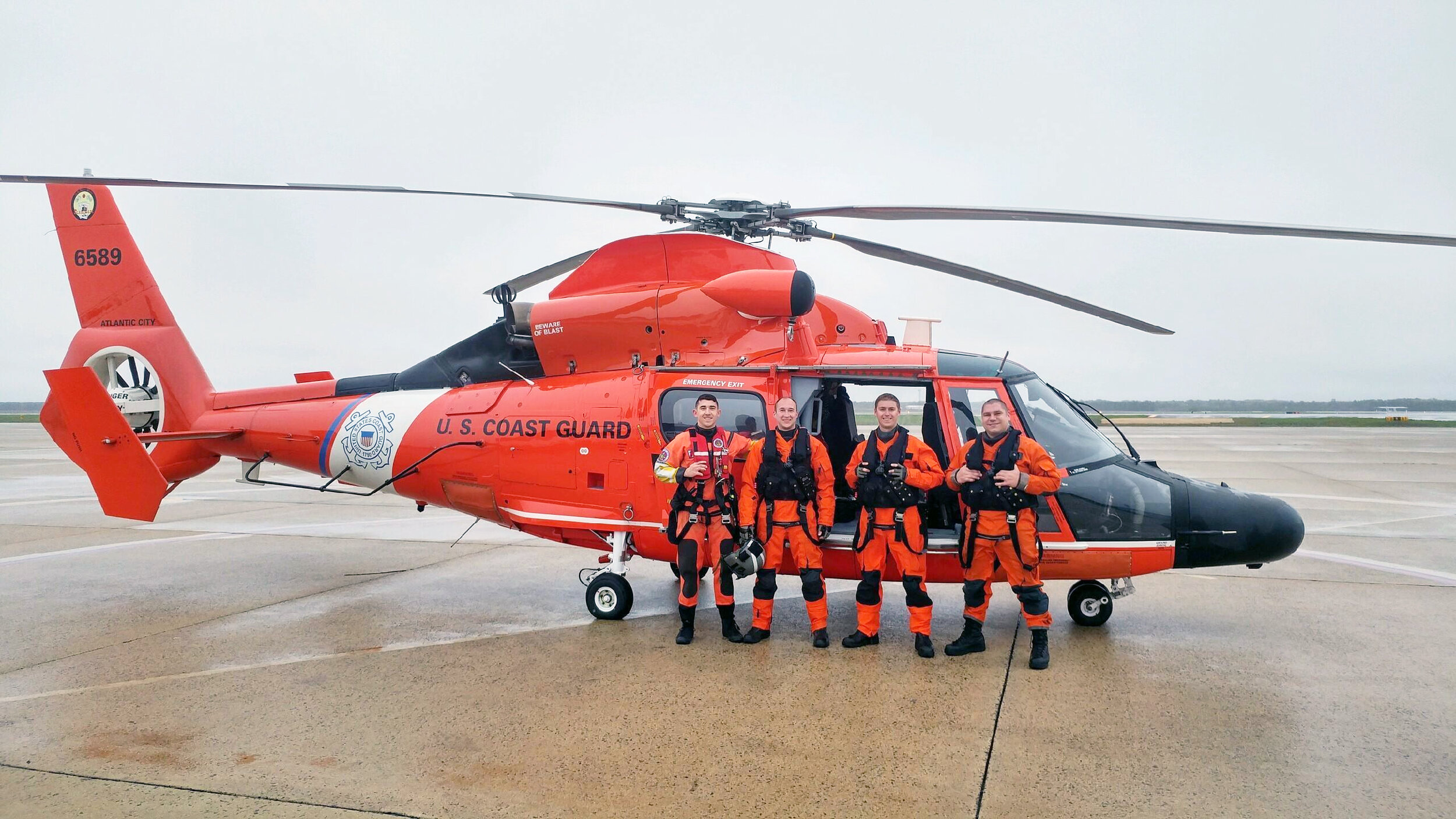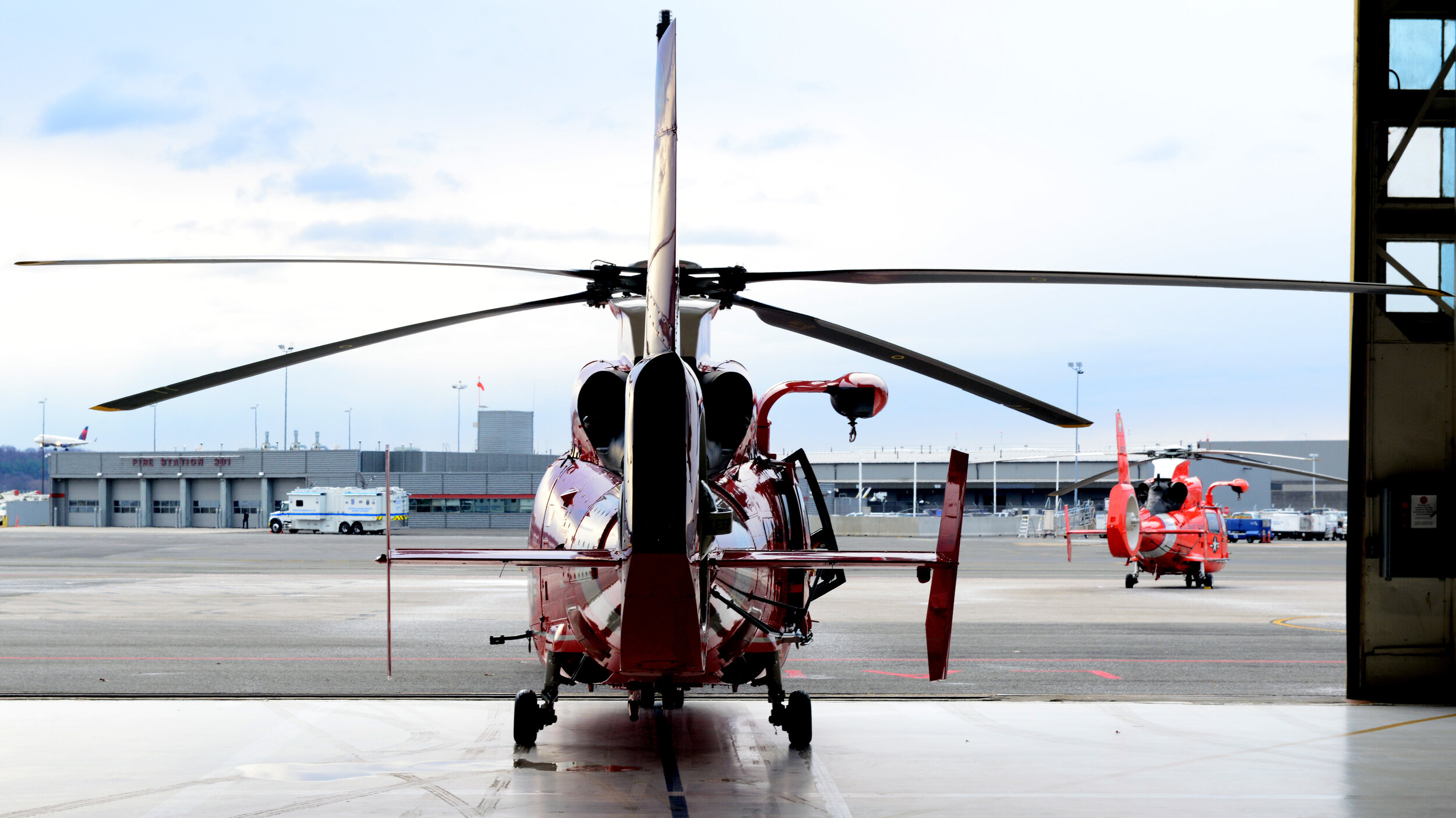Look, Up in the Sky! Things You Might Not Know About the Coast Guard and Its Helicopters
An MH-65 Dolphin rescue helicopter crew medevacs an ill fisherman from the deck of the Coast Guard Cutter Willow approximately 60 miles east of Atlantic City in January 2017.
(U.S. Coast Guard photo by crew of CGC Willow)
If you’re reading this on the beach in the afternoon, you’ve probably already seen an orange helicopter fly by. If you’re like me, you probably have more questions than answers about the United States Coast Guard’s significant presence in our area. Here are a few things that you might not know:
Coast Guard boot camp is in Cape May. Every year, more than 3,500 recruits step off a bus at Training Center Cape May to begin their eight-week journey toward becoming a Coastie. This is the Coast Guard’s only boot camp; all USCG enlisted personnel pass through Cape May.
The helicopters are at the Atlantic City Airport. You can find the Coast Guard Air Station Atlantic City at the Atlantic City International Airport, amid the sprawling Federal Aviation Administration Technical Center at the south end of the runway. On your next Spirit flight to Florida, look for the orange helicopters next to the white jumbo jet. I met Capt. Eric Gleason, a distinguished pilot and the Air Station’s commanding officer, at this spring’s Avalon Home and Land Owners Association meeting. He leads 250-plus “fixers and flyers,” the men and women who maintain and operate the station’s 11 MH-65D Dolphin helicopters day and night year-round.
The helicopters used to be in Cape May. The Coast Guard established Air Station Atlantic City in 1998 by merging air stations in Brooklyn and Cape May into one unit.
Why do we see helicopters so frequently? Capt. Gleason says his pilots regularly fly training flights to South Jersey’s municipal airports. Along the way, they fly along the beachfront looking for boaters or swimmers in distress, a practice that Gleason compares to “cops walking a beat.” As a mariner, I can tell you that I appreciate their regular presence overhead.
Those helicopters are 30 years old! I toured Air Station Atlantic City on a busy Monday morning with Lt. Alexander Currie, an experienced helicopter pilot. In the hangar, I got inside a helicopter! In a MH-65D Dolphin, the two pilots sit side-by-side in front of identical controls and instruments. In the black nose cone is the search radar system. Despite a series of upgrades, most of the MH-65 Dolphin’s cockpit instruments are analog, except for its GPS navigation and a 6-inch square display between the pilots. The Coast Guard expects at least another decade from its 100 Dolphin helicopters at its air stations and deployed onboard cutters.
Helicopters require a lot of maintenance. In the maintenance hangar, we saw scores of enlisted technicians servicing various components of four of the station’s 11 helicopters. The blue coverall-clad mechanics create and execute stringent maintenance schedules that keep these 30-year-old helicopters flying day and night in a harsh saltwater environment. Don’t forget that each aircraft has two engines! When Lt. Currie and his colleagues enter the hangar, he only needs to check the maintenance log and perform a walk-around before taking off on his next mission.
Air Station Atlantic City is busy. Air Station Atlantic City is so busy that its helicopter crews did not deploy to the Gulf Coast following last year’s hurricanes. With responsibilities from Connecticut to the Chesapeake Bay, Capt. Gleason offered that his aviator colleagues rescue around 150 people each year. As I walked the halls with Lt. Currie, I was immediately impressed by the facility’s professional tempo, not unlike a large financial-services company or law firm. Clean-cut aviators in sage green flight suits huddled over laptops, around conference tables, and in front of maps.
Search and rescue is serious business. Air Station Atlantic City always keeps two search-and-rescue helicopters ready to fly within 30 minutes of receiving news. The pilots are responsible for getting the helicopter to those in need. The pilots fly the helicopter to a hover just 50 feet above the ocean. The flight mechanic and rescue swimmer are now responsible for getting those in need into the helicopter. Above the cabin door on the starboard (right) side is a hoist that can lower the rescue swimmer in a harness or in the helicopter’s rescue basket, big enough for one person. You’ve likely seen this in “The Perfect Storm” or on “Deadliest Catch.” Look forward to an upcoming feature on the Coast Guard’s search-and-rescue efforts.


Whether the weather. Whether to fly a mission is the decision of the aircraft commander, the senior pilot onboard. With their experience in instrument flying, Coast Guard pilots regularly fly 150 miles one way in zero-visibility conditions to help mariners in distress. But Air Station helicopter crews have another mission besides search and rescue.
Coast Guard helicopters protect Washington. Coast Guard aircrews also deploy to the National Capital Region, where they provide North American Aerospace Defense Command (NORAD) with the additional ability to interdict low- and slow-flying aircraft in protected airspace around our nation’s capital. Per Capt. Gleason, NORAD keeps these helicopters “on a short leash” so they can be scrambled to intercept aircraft that do not respond to air traffic controllers. Per NORAD, “Coast Guard helicopters perform Rotary Wing Air Intercept operations in the National Capital Region by visually identifying errant aircraft that have violated the special flight rules area and redirect them out of the area.” Instead of a rescue swimmer, the flight mechanic has a digital sign board with which to visually communicate with these aircraft. The sign commonly tells the other pilot(s) to tune the radio to a specific frequency to receive further instructions.
Coast Guard aviators attend Navy Flight School. After graduating from the Coast Guard Academy in 2007, Lt. Currie was first a “ship driver,” managing a team of 30 Coasties on a cutter. Subsequently, he was selected to attend flight school at Naval Air Station Pensacola (Fla.), where all Navy, Marine Corps, and Coast Guard aviators complete basic flight training together; it takes 18 to 24 months to complete. He then attended Coast Guard’s flight school in Mobile, Ala., where he learned to fly the MH-65 Dolphin. This “Transition Course” lasts 6-8 weeks and is used to teach new Coast Guard aviators how to fly the specific aircraft that they’ll fly most of their careers. Upon graduation, he was qualified as a co-pilot in the helicopter. Currie shared that, because Air Station Atlantic City’s unique missions, all East Coast MH-65 pilots fly here in their first or second rotations. After getting his wings, his first stop was at Air Station Miami.
Coast Guard pilots have significant administrative duties beyond flying and training. Coast Guard pilots, all officers, have significant management responsibilities wherever they fly. There is always an officer on duty who is responsible for real-time operations. Also, an officer is responsible for the Coast Guard helicopters that deploy to wherever the president travels around the country.
The Coast Guard’s search-and-rescue mission has local roots. In response to the growing number of 19th century shipwrecks, local volunteers operated life-saving stations in coastal communities on all three coasts. In 1878, Congress formally organized these life-saving stations into a national Life-Saving Service, funding both previously volunteer-led stations and new outposts. Locally, four of those new stations still stand. Strathmere’s Life-Saving Station was moved from Ocean City and rebuilt at its current bayfront location, where it is a private home like Avalon’s. The former Townsends Inlet station is now the Coast Guard recreational facility at 81st and Landis Avenue. Finally, don’t miss the life-saving museum at the Stone Harbor station, remodeled and proudly occupied by the Stephen Ludlam American Legion Post 331.
These are colleagues that I’d want. Lt. Currie and I had coffee in the Ward Room, the officers’ lounge. Incoming pilots were arriving for a week of training. What the environment lacked in formality, it had in respect. Everyone was greeted with enthusiasm and eye contact. A senior officer connected with each of his team. Former colleagues, whether from flight school or otherwise, were old friends all around. These are colleagues I’d want. I’m grateful to Capt. Gleeson for his enthusiasm, Lt. Currie for his time and candor, and Petty Officer Seth Johnson, who arranged my visit to Air Station Atlantic City.
Ready to jump in? Get social! Follow U.S. Coast Guard Air Station Atlantic City on Facebook and @uscg on Instagram to learn more about the Coast Guard’s important missions in our area and beyond.

